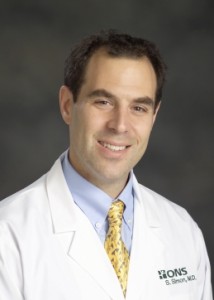Conference Preview: Adolescent Ideopathic Scoliosis: Recognition and Treatment
Scott Simon, MD, will address the Adolescent Ideopathic Scoliosis: Recognition and Treatment at the 6th

Neurosurgeon Dr. Scott Simon
Annual ONSF Medical Education Conference on Saturday, November 8th. Orthopedic surgeons, neurosurgeons, radiologists, sports medicine specialists, physiatrists and physical therapists will present topics related to treatment of musculoskeletal issues unique to females.
Adolescent idiopathic scoliosis (AIS) is the most commonly encountered form of scoliosis where the spine rotates and curves from side to side. This condition presents between 10 and 18 years of age, often in girls, and the cause of the spinal deformity is unknown, hence the term idiopathic. While there are investigations on going into the cause of scoliosis, no one cause has been identified, although approximately 30% of AIS patients have a family history of scoliosis, implying a genetic link. The majority of patients are completely healthy and the curve of their spinal is purely a cosmetic issue and has no bearing on their health. In fact, patients with adolescent Idiopathic scoliosis that also complain of significant pain and/or exhibit abnormal neurological signs or symptoms may require further evaluation beyond a simple x-ray, as such a presentation is not typical of AIS.
AIS is often first noticed during a pediatric well visit or during a school screening where one shoulder may appear higher or one shoulder blade may be more prominent. When AIS is suspected, typically standing X-rays of the entire spine are obtained that allow your physician to measure the degree of the scoliosis and assess the skeletal maturity of the spine. Assessing the skeletal maturity of the spine is important because scoliosis is at greatest risk for progression during periods of growth. Any curve with a cob angle greater than 10 degrees is considered scoliosis.
The three main categories of treatment of adolescent idiopathic scoliosis include observation, bracing, and surgery. Since scoliosis tends to progress during periods of rapid growth, the potential for growth is taken into account when determining what category of treatment is most appropriate. Curves that are less than 25 degrees are generally observed and followed with regular doctor visits while the patient is still growing. Bracing is considered for larger curves, but is only effective in slowing the progression of the curve while the child is growing. Surgery is rarely needed and is generally only reserved for curves greater than 45 degrees, but is the only intervention that has been consistently shown to correct the deformity. Alternative treatments such as chiropractic, physical therapy, yoga, message, etc. have thus far not been shown to be effective treatments of scoliosis.
The 6th Annual ONSF Medical Education Conference will focus on treatment of musculoskeletal issues unique to females. Keynote speaker Joan Lunden, renowned author, journalist and TV host, will share her perspectives on women’s health.




